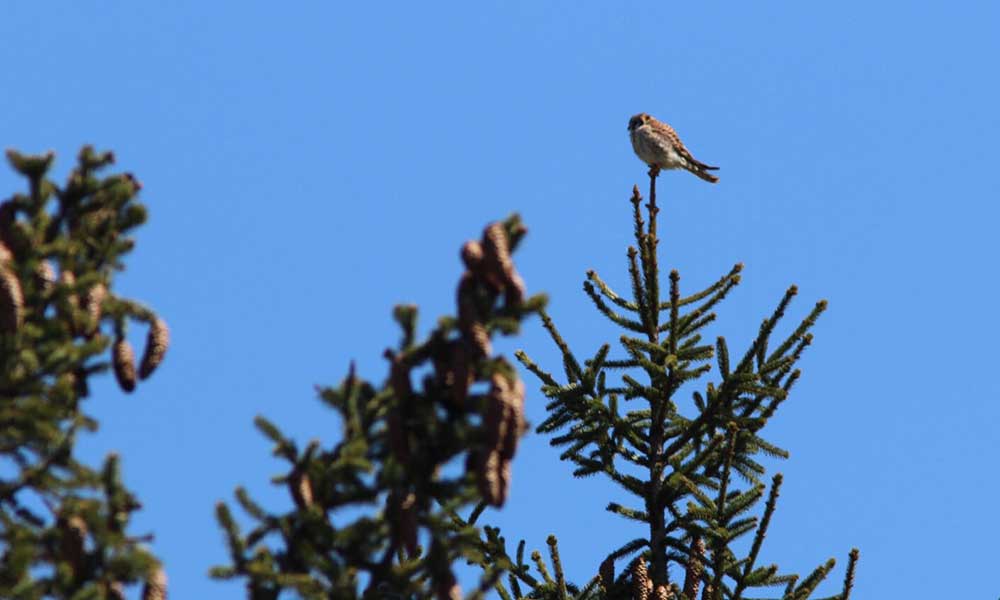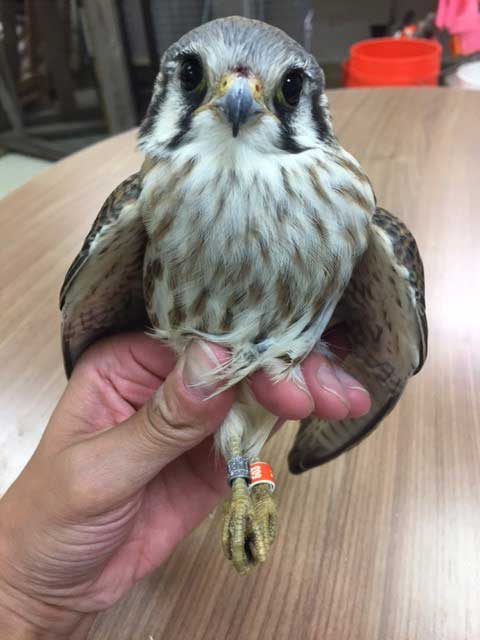Inviting Birds of Prey Raptors to Your Golf Course


American Kestrel after release at Mendham Golf & Tennis Club in New Jersey. (Photo credit: Port Authority of NY-NJ)
If your golf course is already an Audubon Cooperative Sanctuary Program for Golf facility or is in the process of earning this distinction, the next logical step for you as a golf course superintendent or director of golf may be for your course to become part of the Raptor Relocation Network.
In 2017, United Airlines and Audubon International announced the launch of the program, initially designed to target the protection of raptors at select airports in the New York and New Jersey area. Attracting falcons, owls, hawks and other majestic birds of prey to your golf course facility is immediately appealing to environmentally conscientious golf course superintendents and to the golfers who play the course. Plus, there’s the bonus benefit of improving insect and rodent control around the facility. But the potential to reduce bird strikes could be the most important reason of all to become part of the program.
Bird strikes, which are collisions between a bird or birds and an airplane, cost airlines millions of dollars in equipment repair and downtime. More importantly, bird strikes can result in structural damage or engine failure leading to crashes, property damage at the crash site, and passenger and crew injury or loss of life. As Christine Kane, CEO of Audubon International observes, “Being part of the Raptor Relocation Program is a way for our member golf courses to help provide a solution for a much larger issue.”
Why the Problem Exists
Some species of birds intuitively are attracted to airports. Low-lying vegetation, foodservice waste, and water runoff from metal buildings and the storage buildings themselves draw rodents and small mammals. And the presence of rodents and other small animals attracts owls, hawks, kestrels, and other birds of prey classified as raptors.


Frequently, airports are built on the edge of cities, where the environment transitions from urban to suburban or rural. Certain species of raptors are drawn to an airport’s abundance of high places for perching to survey relatively wide-open areas. These same birds will likely love perching in the tallest trees on your golf course to study the vistas down your well-maintained fairways.
The Green-Focused, Golf-Friendly Skies of United
The social impact initiatives of United Airlines include a robust, environmental program focused on protecting and preserving the environment as well as corporate sustainability initiatives dedicated to sustainable aviation fuel and carbon capture.
United enthusiastically partnered with Audubon International and the Port Authority of New York and New Jersey in the plan to relocate raptors to golf courses. With demonstrated success at five participating northeastern airports, the Raptor Relocation Program has since expanded to San Francisco International Airport.
A bi-coastal presence is a big step forward, but clearly, there remain a lot of airports and golf courses across the U.S. that could be benefiting from this program. Of the approximately 1,000 golf courses in the U.S. that are a certified Audubon Cooperative Sanctuary facility, only fifteen courses are part of the Raptor Relocation Program.
Participating in the Raptor Relocation Network
A few Audubon Certified golf courses will find that they are not eligible to be part of the Raptor Relocation program because of their proximity to airports. Typically, a course must be located a minimum of five miles from the closest airport of any size and at least fifteen miles from the nearest major airport. The golf course must be a sufficient distance from the relocation airport so that the raptor will not simply return to its previous home to roost. For migratory birds, such as the American Kestrel, a raptor frequently relocated from the five participating airports in New York and New Jersey, allowances for the bird’s natural migratory path are also critical.
A relocation site must afford a suitable environment for the raptor with sufficient food source and space and appropriate habitat. Although there is a huge benefit for airports in reducing the number of raptors on-site, the program always puts the well-being of the bird first, relocating them to a golf course only when it is logical to assume they will flourish in their new home.
All responsibilities for capture and transfer of each raptor, as well as the permits necessary for these actions, are conducted entirely by airport personnel trained for these responsibilities. Before an ACSP course is selected as an Official Release Site, it must complete a Habitat Evaluation Checklist and pass an on-site assessment conducted by an Audubon International staffer.
Once a course is determined to be a suitable site, an individual at the golf course must assume the responsibility of being an on-call contact person until the relocated raptor is released at the site. This transfer happens quickly, usually with less than a day lapse between the time of the raptor’s capture and its arrival at the course.
After the raptor arrives, the golf course superintendent and his crew have only two additional responsibilities beyond ensuring that their facility remains a suitable environment. The first responsibility is to identify who will act as a designated monitor reporting and documenting sightings of the raptor. This task, of being a citizen scientist, can be assumed by any interested and capable employee of the golf course, a golf course club member, or a community volunteer, and it does not have to be a responsibility of the maintenance crew.
The second task should be shared equally by all who work, play or enjoy the golf facility. It is simply the mandate to pause from time to time, to stand quietly and to look up, taking advantage of the potential opportunity to catch a glimpse of a hawk in flight, an owl dozing on a tall tree branch, or North America’s smallest falcon, the American Kestrel, perched on a nearby wire, contemplating what it might like for lunch.
Audubon International’s Staff Will Take You Under their Wing
The decision to become a member of the Audubon Cooperative Sanctuary Program for Golf is a golf course superintendent’s first step for his or her golf course to participate as an Official Release Site for the Raptor Relocation Network. This decision, however, is far more than a gateway to the raptor program.
The golf course superintendent and crew at an Audubon International Certified Golf Course gain access to experienced insights and customized guidance from the Audubon International staff, along with valuable support as the course’s management and crew pursue enhanced sustainability, stronger community bonds, a safer workplace and the potential for meaningful cost savings. And in case you’re wondering how meaningful, The Bear Trace at Harrison Bay Golf Course, as one example of many, reduced its chemical budget by more than $30,000 in the process of earning ACSP certification. Courses realize savings differently depending upon the steps they have taken, but cost reductions can take the form of labor, fuel, water or other maintenance expenses, often by simply resolving manageable issues most golf course superintendents already had on their radar.
Learn more about how your course can get involved and get results. ACSP for Golf Program https://auduboninternational.org/acsp-for-golf/
Linda Parker has been writing professionally since the 1980s. With clients in finance, sports, technology, change enablement, resorts, and nonprofit global initiatives, Linda helps organizations communicate their stories in meaningful ways to the people they most want to reach. She has authored, ghostwritten, or contributed to more than a dozen nonfiction books. Linda is a member of the Authors Guild and the Golf Writers Association of America. You can connect with her at linda@glindacreative.com.
Recent Posts
Discover Puerto Rico for Great Golf Trips and After-Round Activities, Amenities
Golfers cannot live by the game alone which is why Puerto Rico provides the perfect…
Q&A with a Multi-talented Golf Course Architect – Part 2: Making the Rounds – Installment 39
This column features recollections of the author’s 37 years as a golf writer. These installments…
With LOKSAND, Bunker Faces & Edges ‘Aren’t Going Anywhere’
LOKSAND Global has announced North American availability of the stabilization product LOKSAND (www.loksand.com), in addition…
One of the Biggest Jobs in Golf
When Rory McIlroy finally slipped into the Green Jacket on Sunday, April 13, 2025, after…
Audubon International Marks Earth Day In Growth Mode
As the world celebrates Earth Day on April 22, Audubon International – the environmentally focused non-profit…
Help keep golf sustainable by bidding in GCSAA’s Rounds 4 Research online auction
In celebration of Earth Day, you can help fund the research that advances golf’s environmental…


